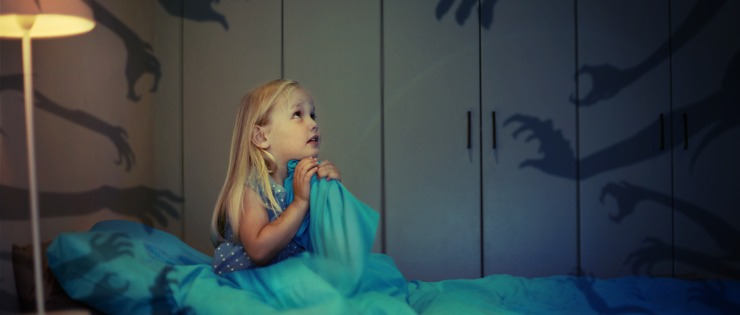Night Terrors
While almost every child will have a nightmare at some point, only 3-6% of children will have a night terror. The most common age group for night terrors to occur is four to 12 years. Around 80% of sufferers have a family member who has had a sleep disturbance.
During night terrors, children will sit upright in bed, have a quicker heartbeat, scream or shout out and be upset or scared. It can be difficult for a parent to console their child during a night terror.
Night terrors are most likely to occur in children who are overtired or stressed, taking a new medication or sleeping in a new environment. Parents can reduce the risk by making sure children don’t stay up too late or become overtired and have a bedroom routine that is relaxing.
REM-Related Parasomnias
During the REM stage of sleep, our eyes move rapidly behind our closed eyelids, breathing is faster as is our heart rate and blood pressure. Fewer parasomnias are experienced during the deeper REM sleep cycle than the lighter cycle.
Nightmares
Nightmares can occur at any age, but are most common in children particularly around the age of 10. A nightmare may be triggered by a scary movie, illness, fever, stress, anxiety, sleep apnea, drugs or alcohol, eating close to bed and medications.
An adult may be able to reduce the frequency of their nightmares by engaging in relaxation techniques before bed, limiting caffeine and alcohol, exercising regularly and establishing a sleep pattern before bed.
Consult a doctor if the nightmares continue over an extended period or make it difficult to function the following day

REM Behaviour Disorder (RBD)
A person may call out or make unusual movements while dreaming. These dreams are often action packed and even violent. The episodes can become more violent as time goes on. Movements may include shouting, swearing, grabbing, punching, jumping, kicking and leaping. Unlike other parasomnias, people can be easily woken from RBD and clearly remember their dream.
Nightmare disorder also occurs with REM sleep. The disorder causes vivid dreams that involve a person’s survival and is common amongst people who suffer from post-traumatic stress disorder (PTSD).
Other Parasomnias
The other category relates to parasomnias that occur while transitioning between sleep and wakefulness or during the other two sleep cycles.
Sleep Enuresis
Bed wetting while asleep is considered a type of parasomnia in people over the age of five and occurs at least twice per week for a minimum of three months.
Sleep Hallucinations
A person may experience a hallucination during the onset of sleep or when they wake up and can be visual, auditory, tactile or kinetic.
Sensory Sleep
When a person hears a loud noise or exploding sensation in their head when they wake up.
Recurrent Isolated Sleep Paralysis
When a person can’t move any part of their body, usually when a person is falling asleep or waking up.
Causes of Parasomnia
Parasomnias often have a genetic link with another family member suffering from parasomnias, or there may be an underlying cause or condition such as:
Treating a potential cause of parasomnia may reduce the number of incidents. Many children grow out of their parasomnia without knowing or treating the cause.

Parasomnia Symptoms
Some people won’t even know they experience parasomnia and have no symptoms. For others though, the disturbance to their sleep during the night makes it hard for them to wake up in the morning feeling rested, meaning they struggle to get through the day without exhaustion.
Those people who wake up after a parasomnia incident may be confused because they’re out of bed (sleepwalking) or sitting upright in bed after sleep talking, a nightmare or terror. It can be difficult to get back to sleep.
People who sleepwalk often bump into objects around the house and when they wake, don’t know why their legs are covered in bruises. A person who sleep eats may notice an injury in the morning after using kitchen utensils to prepare food.
Treatment of Parasomnia
Some parents wait until their child grows out of their parasomnia if it’s not causing too much disruption to their child’s life rather than seek treatment.
For children and adults who feel that their parasomnia is having too great an impact on their daily life, they may look for a suitable treatment. Most people will start by talking to their GP who may provide a referral for a sleep study.
Other types of treatment include:
Hypnosis
Relaxation therapy
Cognitive behaviour therapy
Psychotherapy
Antidepressants
Sleeping pills or melatonin supplements
Treating breathing issues with a device or surgery
Night guard to stop bruxism (teeth grinding)
Vitamins such as zinc and vitamin A
Lifestyle changes have also been found to help reduce the frequency of parasomnia episodes such as:
Only working days, not nightshift
Going to bed at the same time each night
Getting a full night’s sleep
Avoiding alcohol and drugs